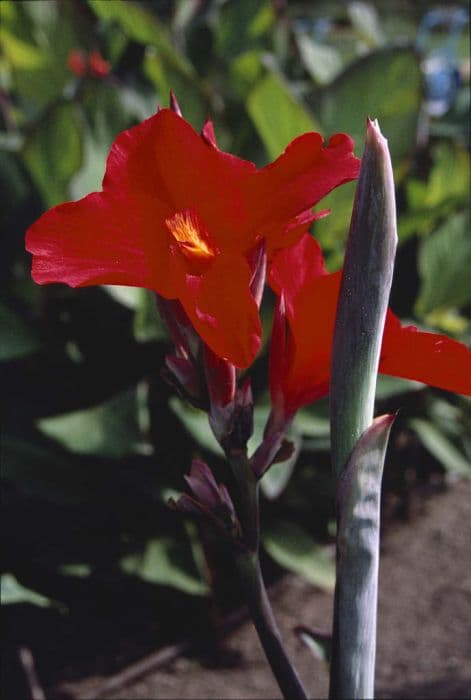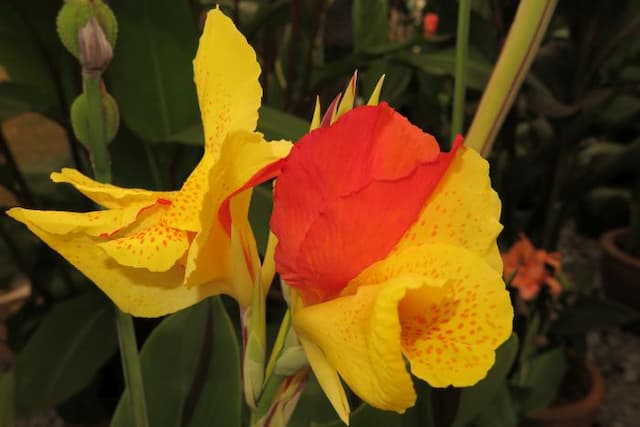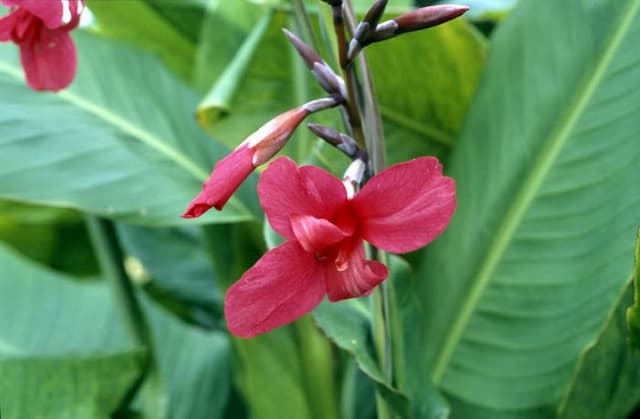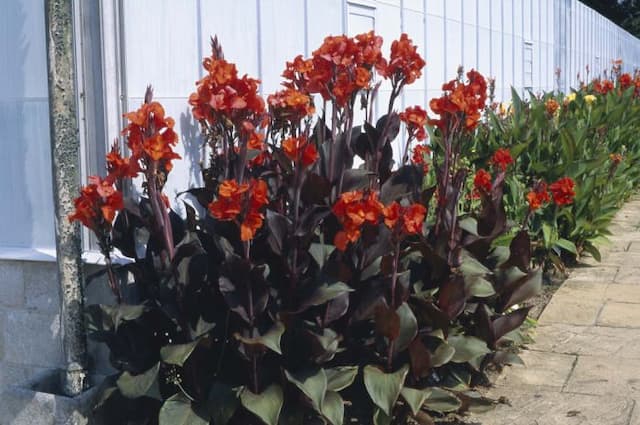Queen Charlotte Canna Canna 'Königin Charlotte'

ABOUT
Canna 'Königin Charlotte', commonly known as Queen Charlotte canna, is a striking plant showcasing lush, green foliage. The leaves are often broad and paddle-shaped, giving a tropical appearance. This canna's most captivating feature is its flowers, which are impressively displayed in bold hues. The blossoms are usually a radiant shade of orange, edged with a contrasting band of gold or yellow, providing a fiery and regal display. The flowers are typically arranged in clusters on a central stem that rises above the foliage, creating a dramatic visual impact. The Queen Charlotte canna exudes a classic and stately charm, with its bright blooms that attract both the eye and pollinators such as hummingbirds and bees. Its overall appearance is one of robust vibrancy, making it a popular choice for gardeners looking to add a touch of majesty to their outdoor spaces.
About this plant
 Names
NamesFamily
Cannaceae
Synonyms
Queen Charlotte Canna, Canna Lily, Canna 'Queen Charlotte'
Common names
Canna x generalis 'Queen Charlotte', Canna 'Queen Charlotte'
 Toxicity
ToxicityTo humans
Canna Lily 'Königin Charlotte' is not considered toxic to humans. Therefore, if ingested, it is not expected to cause poisoning or serious side effects. However, as with any non-edible plant, it is possible for sensitive individuals to experience mild gastrointestinal discomfort if parts of the plant are ingested.
To pets
Canna Lily 'Königin Charlotte' is generally not considered toxic to pets such as dogs and cats. It is not known to cause serious poisoning if pets ingest parts of the plant. Nevertheless, consumption of non-food items by pets can lead to gastrointestinal upset, so monitoring your pet for signs of discomfort after ingestion is recommended.
 Characteristics
CharacteristicsLife cycle
Perennials
Foliage type
Deciduous
Color of leaves
Varies
Flower color
Mixed
Height
3-4 feet (0.91-1.22 meters)
Spread
1-2 feet (0.3-0.6 meters)
Plant type
Bulb
Hardiness zones
7
Native area
Central America
Benefits
 General Benefits
General Benefits- Attractive Foliage: Canna 'Queen Charlotte' has broad, tropical-looking leaves that add lushness and a tropical feel to any garden setting.
- Vibrant Flowers: It produces striking flowers, usually in shades of red, orange, or yellow, which can be a focal point in any garden design.
- Easy to Grow: This plant is known for being easy to care for, requiring minimal maintenance once established.
- Rapid Growth: Can provide quick coverage due to its fast growth rate, making it suitable for filling spaces in the landscape.
- Drought Tolerance: Once established, it is relatively drought-tolerant, needing occasional watering during extended periods of dryness.
- Attracts Wildlife: The bright flowers of Canna 'Queen Charlotte' attract pollinators such as bees, butterflies, and hummingbirds to the garden.
- Season-Long Bloom: The plant can flower continuously from late spring to frost, offering long-lasting color throughout the growing season.
- Versatile Planting Options: Suitable for planting in beds, borders, and as a specimen plant; can also grow in containers or as part of a water garden.
 Medical Properties
Medical PropertiesThis plant is not used for medical purposes.
 Air-purifying Qualities
Air-purifying QualitiesThis plant is not specifically known for air purifying qualities.
 Other Uses
Other Uses- Canna lilies can be used as a natural dye for fabrics and materials, offering a range of colors from their flowers and foliage.
- The robust leaves can be used in crafting as a natural form of paper for artistic projects or eco-friendly wrapping material.
- Dried canna leaves can be woven to create biodegradable plates and bowls for serving food at eco-conscious events.
- The flowers could be used in the production of natural inks for artistic or calligraphy purposes.
- Canna lily seeds, being hard and black, are sometimes used in jewelry making or as beads in handicrafts.
- The plant's large leaves may be employed as a natural mulch in gardens, slowly decomposing to enrich the soil with nutrients.
- During their growth, canna lilies can be strategically placed to act as a privacy screen or natural barrier in gardens due to their dense foliage.
- The stalks of canna lilies could be used as natural stakes or support structures for other climbing plants in the garden.
- After harvesting the rhizomes for propagation, the remaining plant material can be composted to create a rich organic amendment for garden soils.
- The plant's ability to rapidly grow and propagate in water can make them a suitable choice for erosion control along waterbanks or in water gardens.
Interesting Facts
 Feng Shui
Feng ShuiCanna Lily is not used in Feng Shui practice.
 Zodiac Sign Compitability
Zodiac Sign CompitabilityCanna Lily is not used in astrology practice.
 Plant Symbolism
Plant Symbolism- Lust and Sexuality: Canna lilies, with their lush and vibrant blooms, often symbolize the steamy and passionate aspects of life, reflecting an attraction to the raw beauty of nature and sometimes a representation of lust and sexuality.
- Confidence: The bold presence of the Canna lily, particularly the striking 'Königin Charlotte' with its proud stance and bright colors, can represent self-assuredness and the confidence to stand out in a crowd.
- Wealth and Prosperity: In some cultures, the opulent appearance of the Canna lily's flowers may be linked to abundance and the idea of wealth, much like the way their lush growth can take over a space.
- Pride: The height and stature of the Canna lily, along with the rich, royal connotations of the name 'Königin Charlotte,' which means 'Queen Charlotte' in German, can symbolize pride and sometimes a sense of superiority or regality.
 Water
WaterThe Canna Lily should be watered thoroughly, with enough water to saturate the soil around the root zone. During the growing season, water the plant once every two to three days, ensuring it receives approximately 1 to 1.5 gallons of water each week, depending on the climate and soil moisture. Reduce watering in the cooler months or during periods of rain to avoid waterlogging. It is important to water the plant deeply to encourage deep root growth, which can be done by allowing water to trickle slowly into the soil.
 Light
LightCanna Lilies thrive in full sunlight and should be placed in a spot where they can receive at least six hours of direct sunlight each day. However, in extremely hot climates, they can benefit from some afternoon shade to prevent overheating. The best location for a Canna Lily is an area with bright, unfiltered sunlight for the majority of the day.
 Temperature
TemperatureThe ideal growing temperature for Canna Lilies is between 60 and 90 degrees Fahrenheit. They can survive in temperatures as low as 55 degrees Fahrenheit, but growth may slow or stop. In winter, it is important to protect them from frost, which can be fatal. Ensure the Canna Lily is in an environment well-suited for its temperature needs, avoiding excessively cold drafts or extreme heat.
 Pruning
PruningPrune Canna Lilies to remove old flowers and seed pods to encourage new blooms, and cut back foliage in the fall after the first frost. Deadheading, or the removal of spent blooms, can be done throughout the growing season. Pruning is typically done annually, and the best time is in the late fall or early winter when the plant begins to go dormant.
 Cleaning
CleaningAs needed
 Soil
SoilCanna Lilies like a well-draining, rich, loamy soil with a pH of 6.0 to 6.5. A mixture of garden soil, compost, and perlite or sand works well to provide the nutrients and drainage they need.
 Repotting
RepottingCanna Lilies should be repotted every 2 to 3 years or when they outgrow their current pot to allow for continued growth and bloom production.
 Humidity & Misting
Humidity & MistingCanna Lilies thrive in high humidity environments, ideally between 60% to 70%; they're well-suited for outdoor settings where this is naturally provided.
 Suitable locations
Suitable locationsIndoor
Place in bright, indirect light with room to grow.
Outdoor
Plant in full sun, fertile soil, and space 2 feet apart.
Hardiness zone
7-10 USDA
 Life cycle
Life cycleThe 'Queen Charlotte' canna begins its life cycle when a rhizome is planted in the soil, typically in early spring after the last frost date. The rhizome sprouts and grows into a lush plant, with large leaves and stems, reaching maturity and full size within a few months. Throughout the summer, the canna produces striking flowers with a combination of red, pink, and yellow hues, attracting pollinators. After the flowering period, which can last several weeks, the plant sets seeds that can be collected for future propagation, although many gardeners prefer to propagate canna by dividing rhizomes. As temperatures cool down in the fall, the above-ground foliage dies back, and the canna enters a period of dormancy over the winter months. In the spring, the cycle begins anew when the rhizomes can be divided and replanted, giving rise to new plants.
 Propogation
PropogationPropogation time
Spring-Early Summer
Propogation: Canna 'Königin Charlotte', commonly known as Queen Charlotte canna, is generally propagated by dividing its rhizomes. The best time to propagate cannas is in spring after the last frost when the soil has warmed up, as this encourages quick sprouting and growth. To propagate, carefully dig up the rhizomes and use a sharp, clean knife or spade to divide the root mass into sections. Each section should have at least one eye or bud. Replant the divisions about 3 to 4 inches deep (approximately 7.5 to 10 cm) and about 18 to 24 inches apart (45 to 60 cm). This direct division of the rhizomes ensures the new plants will be true to the parent plant and can quickly establish to bloom in the same season.









